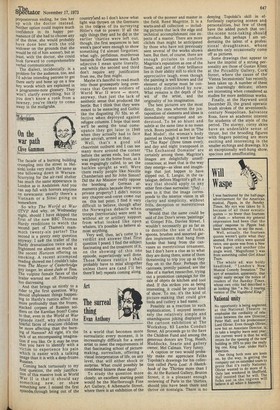Art
The surreal thing
Evan Anthony
In a world that becomes more surrealistic every moment, it is increasingly difficult for a mere artist to meet the requirements of that fascinating school of picturemaking, surrealism, offering a visual interpretation of life, on any level, that will either shock or surprise. What could possibly be considered bizarre these days?
To study the question more closely, an excellent starting point would be the Marlborough Fine Art Gallery, 6 Albemarle Street, where there is an exhibition of the work of the pioneer and master in the field, Rend Magritte. It is a warts-and-all collection — including pictures that lack the edge and technical accomplishment one expects of a master. There are more clichds than might be anticipated by those who have not previously seen several of the works shown here. But then, of course, there are enough pictures to confirm Magritte's reputation as one of the finest, and part of their brilliance lies in their ability still to elicit the appreciative laugh, even though the painting is well known and the element of surprise must be considerably diminished by now. What remains is the depth of the wit of the artist, and the originality of his imagination.
The best pictures are the most direct, the ones wherein the juxtaposition of elements and ideas is immediately recognised and understood. To be so blunt and subtle at the same time is no mean trick. Boots painted as feet in 'The Red Model'; the woman's body painted as though it were her face in 'The Rape' (three times over); and day and night transposed in 'The Enchanted Domaine' are certainly among these. Magritte's images are delightfully unselfconscious; at least that is the way they emerge—as ideas and imaginings that just happen to have slipped out. E. Langui, in the catalogue, defines Magritte's gift in a way that should apply to any other first-class surrealist: "[he] sees to it that the image corresponds to the interior vision in all clarity and simplicity, without frills, deception or meretricious ornament."
Would that the same could be said of Jim Dine's seven 'paintings' at Gimpel Fils, Davies Street. I wouldn't necessarily go so far as to describe the use of forks, spoons, brushes and assorted garden implements that hang from hooks that hang from the canvases as meretricious ornament, but I don't have a clue as to what they are doing there, some of them threatening to trip you up as they flop on to the floor. Perhaps the canvases, prettily painted, are the idea of a market researcher, trying out a promotion campaign for the sale of objets de kitchen and tool shed. If this strikes you as being interesting, it could be your kind of show. To me, it's the kind of picture-making that could give tools and cutlery a bad name.
Possibly as a reaction to such sophistication, I enjoyed immensely the relatively simple and unambiguous joking displayed in the cartoon exhibition at The Workshop, 83 Lambs Conduit Street. All proceeds go to the Save the Children Fund and among the generous donors are Trog, Heath, Maddocks, Searle and gallery owner, Mel Calman. Very funny.
A caption or two would probably make me appreciate Feliks Topolski's drawings for his collection called Paris Lost: A Sketchbook of tne 'Thirties more than I do. At the Rutland Gallery, Bruton Street, it is a pleasant enough reviewing of Paris in the 'thirties, should you have been there and thrive on nostalgia. There is. no
denying Topolski's skill in effortlessly capturing scenes and personalities, but few of them have the added punch that onthe-scene note-taking should produce. But perhaps I am underrating the talent of a professional draughtsman, whose sketches only occasionally come off as pictures.
Some drawings that appear to have the imprint of a strong personality are those of Gustav Klimt at the Piccadilly Gallery, Cork Street, where the cause of the 'Vienna Secessionists' has recently been taken up. A number of them are charmingly delicate; others are interesting when considered as studies for more ambitious works.
Finally, at the Hayward until December 23, the grand operatic brush strokes of the seventeenthcentury Neapolitan, Salvatore Rosa, have an academic interest for students of the style of the period. The stormy, corny skies have an undeniable sense of thrust, but the brooding figures with fingers pointing are more exciting and interesting in the smaller etchings and drawings. It's an exceptionally well-hung show, spacious and unsuffocating.


































 Previous page
Previous page